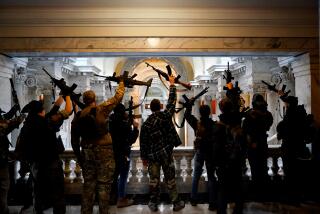In defense of guns
THE TRAGEDY at Virginia Tech may tell us something about how a young man could be driven to commit terrible actions, but it does not teach us very much about gun control.
So far, not many prominent Americans have tried to use the college rampage as an argument for gun control. One reason is that we are in the midst of a presidential race in which leading Democratic candidates are aware that endorsing gun control can cost them votes.
This concern has not prevented the New York Times from editorializing in favor of “stronger controls over the lethal weapons that cause such wasteful carnage.” Nor has it stopped the European press from beating up on us unmercifully.
Leading British, French, German, Italian and Spanish newspapers have blamed the United States for listening to Charlton Heston and the National Rifle Assn. Many of their claims are a little strange. At least two papers said we should ban semiautomatic assault weapons (even though the killer did not use one); another said that buying a machine gun is easier than getting a driver’s license (even though no one can legally buy a machine gun); a third wrote that gun violence is becoming more common (when in fact the U.S. homicide rate has fallen dramatically over the last dozen years).
Let’s take a deep breath and think about what we know about gun violence and gun control.
First: There is no doubt that the existence of some 260 million guns (of which perhaps 60 million are handguns) increases the death rate in this country. We do not have drive-by poisonings or drive-by knifings, but we do have drive-by shootings. Easy access to guns makes deadly violence more common in drug deals, gang fights and street corner brawls.
However, there is no way to extinguish this supply of guns. It would be constitutionally suspect and politically impossible to confiscate hundreds of millions of weapons. You can declare a place gun-free, as Virginia Tech had done, and guns will still be brought there.
If we want to guess by how much the U.S. murder rate would fall if civilians had no guns, we should begin by realizing -- as criminologists Franklin Zimring and Gordon Hawkins have shown -- that the non-gun homicide rate in this country is three times higher than the non-gun homicide rate in England. For historical and cultural reasons, Americans are a more violent people than the English, even when they can’t use a gun. This fact sets a floor below which the murder rate won’t be reduced even if, by some constitutional or political miracle, we became gun-free.
There are federally required background checks on purchasing weapons; many states (including Virginia) limit gun purchases to one a month, and juveniles may not buy them at all. But even if there were even tougher limits, access to guns would remain relatively easy. Not the least because, as is true today, many would be stolen and others would be obtained through straw purchases made by a willing confederate. It is virtually impossible to use new background check or waiting-period laws to prevent dangerous people from getting guns. Those that they cannot buy, they will steal or borrow.
It’s also important to note that guns play an important role in selfdefense. Estimates differ as to how common this is, but the numbers are not trivial. Somewhere between 100,000 and more than 2 million cases of self-defense occur every year.
There are many compelling cases. In one Mississippi high school, an armed administrator apprehended a school shooter. In a Pennsylvania high school, an armed merchant prevented further deaths. Would an armed teacher have prevented some of the deaths at Virginia Tech? We cannot know, but it is not unlikely.
AS FOR THE European disdain for our criminal culture, many of those countries should not spend too much time congratulating themselves. In 2000, the rate at which people were robbed or assaulted was higher in England, Scotland, Finland, Poland, Denmark and Sweden than it was in the United States. The assault rate in England was twice that in the United States. In the decade since England banned all private possession of handguns, the BBC reported that the number of gun crimes has gone up sharply.
Some of the worst examples of mass gun violence have also occurred in Europe. In recent years, 17 students and teachers were killed by a shooter in one incident at a German public school; 14 legislators were shot to death in Switzerland, and eight city council members were shot to death near Paris.
The main lesson that should emerge from the Virginia Tech killings is that we need to work harder to identify and cope with dangerously unstable personalities.
It is a problem for Europeans as well as Americans, one for which there are no easy solutions -- such as passing more gun control laws.
More to Read
Sign up for Essential California
The most important California stories and recommendations in your inbox every morning.
You may occasionally receive promotional content from the Los Angeles Times.










